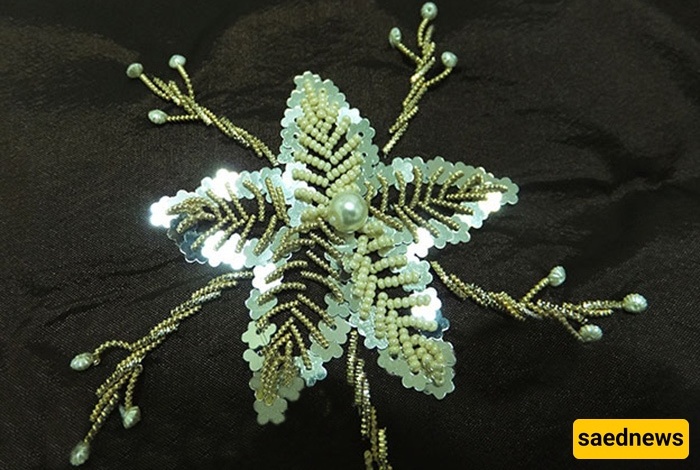Zoghreh Doozi is a type of embroidery, and in this content, we want to get acquainted with this art. Stay with Saed News.

Zoghreh Doozi or Zhoghreh Doozi means metal embroidery. In the past, the sequins were made from precious metals such as gold and silver, and the filigree (mellileh) was also handmade from the same materials. This type of embroidery, which is very delicate and pleasing, usually created a wide band formed by two parallel lines side by side. It was used to decorate the edges of garments around the collar, chest area, coat hems, and large curtains.
This delicate embroidery is done in two stages: first Zoghreh, then Jalveh Doozi. Jalveh Doozi is an embellishing stitch that must be done on the seam and between the base stitches. Jalveh Doozi is the finishing stage of Zoghreh Doozi, which greatly enhances the beauty of the work. Today, Zoghreh and Jalveh Doozi are used for stitching sacred names, decorating Termeh fabric bundles, evening dresses, and more. In the past, this embroidery was only used in Yazd and Isfahan, but unfortunately today there is hardly any trace left of this beautiful craft.
Zoghreh Doozi refers to sewing gold or silver thread or sequins onto fabric or clothing. In needlework, it specifically refers to a kind of sequin embroidery where instead of beads, small cut pieces of metallic thread (sorme) are used. This needlework is mostly used to fill and embellish the background. Artists often combined this embroidery with others like sorme embroidery, pile embroidery, and Bukhara embroidery to create mixed effects. In Bukhara embroidery, Zoghreh Doozi is used alongside the main Bukhara stitch. Another type of Zoghreh Doozi exists that is specific to Tehran, Isfahan, and sometimes Hormozgan province. This art is also popular in Kashan and Tabriz.

Simple stitch: Usually used for filling the background. The needle is passed through the fabric from underneath and brought out through the sequin hole. A short piece of metallic thread is threaded through, and the needle is then passed back through the sequin hole into the fabric.
Round stitch: Used for small flowers and isolated pieces. Similar to the simple stitch, but a metallic thread piece about 5 mm long is placed in the center of the sequin. This is repeated to complete the circular flower design.
Symmetrical or double-sided stitch: Used for outlining shapes, usually petals. The needle passes through the fabric from underneath and out through the sequin hole, holding a 5 mm metallic thread piece, then is inserted into the middle line of the petal. This is done symmetrically so that one end of the metallic thread is on the center of the sequin and the other on the petal’s middle line, forming a slanted, zigzag pattern from both sides.
Chevron stitch: Used for plant shapes, especially leaves. Sequins are sewn around the leaf’s edge, and metallic threads are woven in a zigzag pattern along the central vein.
Knotted stitch: Used for petals and similar shapes. First, a sequin is sewn onto the fabric with a half-centimeter metallic thread extending in a line. Then, knots are tied on the metallic threads running over the sequins using a string threaded through the metallic pieces.

For Zoghreh Doozi, you need various sequins and metallic threads, strong thread, different fabrics, pearls, and silk cocoons. Designs often include flowers and paisleys, birds and flowers, landscapes, animal motifs, and more. This art is also used to decorate panels, tablecloths, bedspreads, table covers, and embroidered Termeh.
Artists, to beautify their works even more, have combined Zoghreh Doozi with other arts such as sorme embroidery, sequin embroidery, and Bukhara embroidery.

